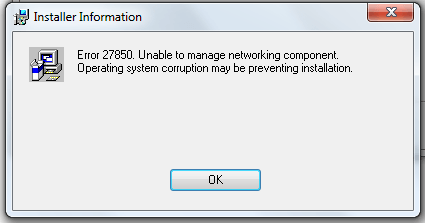After my wireless issue on the Windows 10 I want to install newly the older Cisco Systems VPN Client.

While installing the client you may get an error saying Error 27850: Unable to Manage Networking Component Operating system Corruption may be preventing installation.


Cisco VPN Error 27850 Unable to Manage Networking Component. DNE extends operating systems and network protocol devices and stacks to introduce measurement and controls. Our customers use these extensions to build products that do things like intrusion detection, VPNs, Network Address Translation (NAT), traffic measurement, response time measurement, bandwidth control, compression, content filtering, content protection, policy management, proxies. Cisco Anyconnect is an easy to use,reliable and highly secure mobility client which provides secure VPN to users regardless where they are working from. On a single click,one is connected to office environment from anywhere and is safe and malware threat proof.
Resolution
Unable To Manage Networking Component Cisco Vpn Network
- Ensure you are using the latest version of Cisco VPN Client: the most recent version is now 5.0.07.0440.
- Pre-Install the DNE software: the issue seems to be with Cisco’s installer not being able to make the required changes to fully add the DNE driver to the system. You can get this from Citrix’s site here:http://www.citrix.com/go/lp/dne.html
- Install the Cisco VPN Client: the Cisco software should now work.
Now you should be able to add your VPN profiles and start correctly.
UPDATE: if you get an error 2738during the software upgrade or installation use the following command to delete a registry key:

Cisco Networking Pdf
reg delete “HKCUSOFTWAREClassesWow6432NodeCLSID{B54F3741-5B07-11CF-A4B0-00AA004A55E8}” /f
If you still have any trouble please don’t hesitate to contact me! We will found a solution 🙂
An antiquated version of Cisco VPN used by a new client was being stubborn and failing to install on my machine. I was getting error 27850, stating something in my system was “corrupted”.
I had a hunch that the installer was conflicting with Cisco AnyConnect, a more modern version of Cisco’s VPN implementation, a program I had uninstalled after finishing up at a previous client.
I dumped the MSI installer log file and sifted through to find a more detailed error.
And the result was a 1MB text file. The concerning portion was:
MSI (s) (C8:BC) [14:39:31:368]: Invoking remote custom action. DLL: C:WINDOWSInstallerMSI19B4.tmp, Entrypoint: InstallDNE
1: DNECA: RunDNEInstall dneinst command line ‘”C:Program FilesCommon FilesDeterministic NetworksCommon Filesdneinst.exe” -Install -InstallPath “C:Program FilesCommon FilesDeterministic NetworksDNE”‘
Action 14:39:31: Managing Network Components. Installing Network Components. This may take several minutes.
Managing Network Components: Working (1)
MSI (c) (80:10) [14:39:32:720]: Note: 1: 2262 2: Billboard 3: -2147287038
1: DNECA: -2147467262 (0x80004002)
Internal Error 2835. ErrorIcon, ErrorDialog
not found on dialog ErrorDialog
Error 27850. Unable to manage networking component. Operating system corruption may be preventing installation.
MSI (s) (C8!74) [14:39:33:955]: Product: Cisco Systems VPN Client 5.0.07.0290 — Error 27850. Unable to manage networking component. Operating system corruption may be preventing installation.
1: DNECA: —–>> InstallDNE Exit exception handler returning g_iExitCode=0x643
CustomAction Dne64InstallExecFn.BEE04CD6_610D_4F5B_AC11_6AD2E290CC1D returned actual error code 1603 (note this may not be 100% accurate if translation happened inside sandbox)
It looked like the DNE portion of the VPN was failing to install. After some more searching I found a separate installer for DNE on Citrix’s website. I downloaded and installed the DNE installer. When trying to install it threw an error about a registry key. It was unable to modify HKLM/SYSTEM/CurrentControlSet/Services/DNE. I deleted this registry key and re-ran the installer. It went through successfully! After that I ran the original VPN installer, which also worked!
Of course that wasn’t the end of it. After importing the client’s VPN connection information, I got error “Reason 442: Failed to enable Virtual Adapter”
The mighty Google lead me to an IT That Should Just Work post solving this issue via a simple registry edit. After modifying the name of the adapter the VPN was then able to connect!
Open regedit
Browse to the registry key HKLMSYSTEMCurrentControlSetServicesCVirtA
Select the display name to modify:
x86 – “@oem8.ifn,%CVirtA_Desc%;Cisco Systems VPN Adapter” to “Cisco Systems VPN Adapter”
x64 – “@oem8.ifn,%CVirtA_Desc%;Cisco Systems VPN Adapter for 64-bit Windows” to “Cisco Systems VPN Adapter for 64-bit Windows”
Related
